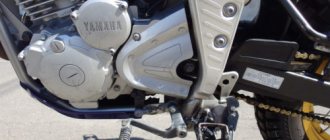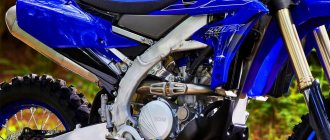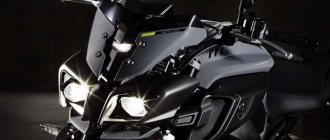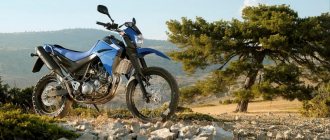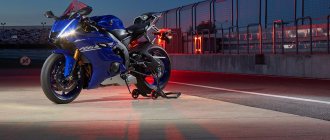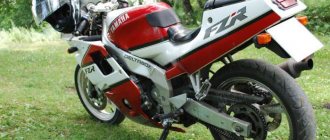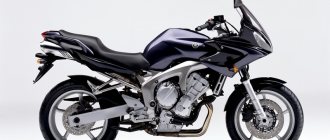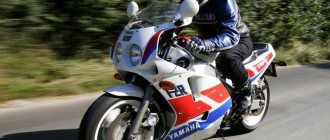| Yamaha YZF750R (1993-1998) | Yamaha YZF750SP (1993-1997) |
Yamaha YZF750R sports motorcycle model
appeared in 1993, replacing the Yamaha FZR 750 Genesis.
Instead of the YZF750R, a “track” modification appeared - Yamaha YZF750SP
. It featured a single seat (the regular version also had the option of installing a cover in place of the passenger seat), the abbreviation "SP" on the plastic, gearbox ratios, Keihin FCRD39 flat-choke carburetors and Ohlins rear suspension (the regular version received this by 1996).
The Yamaha YZF 750 was based on an in-line 4-cylinder liquid-cooled engine with a volume of 749 cm³ and producing 125 hp. power and 80 Nm of torque. Domestic versions were “strangled” to 77 hp. and 59 Nm.
Other features of the model include an aluminum Deltabox frame, adjustable sports suspension, 6-piston front brakes, a 6-speed gearbox, a 19-liter fuel tank and a curb weight of 215 kg.
In 1995, the Yamaha YZF750R was recognized as the best motorcycle of the year according to several magazines.
In 1996, the regular version of the Yamaha YZF750R received the swingarm and Ohlins rear shock absorber from the track version of the Yamaha YZF750SP.
1998 was the last year of production of the model, after which the model finally left the assembly line. As a successor to the Yamaha YZF 750, a small-scale (500 pcs) model of the Yamaha R7 (YZF-R7) was released, which became the last Yamaha sports motorcycle in the class of 750 cc models.
The main competitors of the Yamaha YZF 750 in the class:
- Kawasaki ZX-7R Ninja
- Suzuki GSX-R 750
Brief history of the model
- 1993 - official start of production and sales of the Yamaha YZF 750.
Model
: Yamaha YZF750R;
Yamaha YZF750SP (Europe, Japan). Factory designation
: 4FM1, 4FN1, 4HD1, 4HD2, 4HN1, 4HR1, 4HT1; 4JD1, 4HS1, 4HS2.
- 1994 - no significant changes.
Model
: Yamaha YZF750R;
Yamaha YZF750SP (Europe, USA). Factory designation
: 4FM2, 4FN2, 4HD3, 4HD4, 4HN2, 4HR2, 4HT2, 4HY2, 4JA2, 4LE1, 4LE2; 4HS3, 4HS4.
- 1995 - no significant changes.
Model
: Yamaha YZF750R;
Yamaha YZF750SP (Europe, Japan). Factory designation
: 4FM3, 4HD5, 4HD6, 4HN3, 4HR3, 4HT3, 4HY3; 4JD2, 4HS5, 4HS6.
- 1996 - The Yamaha YZF 750 R version receives the rear swingarm and Öhlins suspension from the SP version.
Model
: Yamaha YZF750R;
Yamaha YZF750SP (Europe, USA). Factory designation
: 4FM4, 4HD7, 4HD8, 4HN4, 4HR4, 4HT4, 4HY4, 4JA4, 4LE3, 4LE4; 4HS7, 4HS8.
- 1997 - no significant changes.
Model
: Yamaha YZF750R;
Yamaha YZF750SP (Europe, USA). Factory designation
: 4HY5, 4LE5, 4LE6.
- 1998 is the last year of production of the model.
Model
: Yamaha YZF750R (Europe, USA).
Factory designation
: 4HY6, 4LE7, 4LE8.
The Yamaha YZF 750 is a typical representative of sports motorcycles of the late 20th century. It was produced from 1993 to 1998, becoming one of the last representatives of 750 cc Yamaha sports motorcycles, not counting the small-scale R7 model. Developed in the early 90s, the YZF 750 is actually a very deep and redesigned version of the Yamaha FZR 750. However, the motorcycle was also produced in two versions - the R, the regular version, and the single-seat SP modification, which also differed in carburetors and other gear ratios. However, it does not occur often.
Competing with such a popular motorcycle as the Suzuki GSX-R750, Yamaha designers had to present something special to the public. We can say that they coped with their task - the YZF 750 turned out to be a more successful model in commercial terms than its predecessor. Extremely powerful, attractively designed and capable of pumping out enormous amounts of adrenaline, this motorcycle won the People's Choice Award.
The aluminum frame, developed for the FZR 750 Genesis, migrated here unchanged. The Yamaha YZF 750 engine was also inherited from its predecessor, albeit in a highly modified form - this in-line four began to produce 125 hp. and 80 Nm of torque, while the engine became more revving, reaching peak power at approximately 12,000 rpm. It noticeably lacks low end, and the response to the throttle at idle is very nervous. If you don't turn the gas up a little, the motorcycle starts to twitch and try to stall; if you turn it too hard, it roars forward with unexpected agility.
Otherwise, the Yamaha YZF 750 is an example of an excellent sportbike, even without a discount on the years of its development and production. The 6-speed gearbox works like a clock, even now, despite the age and mileage of all the motorcycles - the Japanese have put a colossal resource into it. Acceleration from 0 to 100 km/h takes 3.3 seconds, and the maximum speed of the YZF 750 is 260 km/h, which gives it the opportunity to compete on equal terms even with competitors who are a couple of decades younger than it. Yes, in the 90s, technology was made by engineers, not marketers...
The riding position on the motorcycle is typical for the sports class - the driver’s footpegs are set back slightly, and the clip-ons are lowered down, which invites you to lie with your chest on the gas tank and hide from the wind flow behind the fairing, which, subject to such a landing, copes with the wind at any speed up to to maximum. However, it is not so comfortable for the passenger to sit, and besides, the wind blows directly into his helmet, if the height does not allow the second number to completely hide behind the pilot. But what pleased me were the brakes - compared to the FZR 750, this is simply something; powerful 6-piston calipers on the front discs allow the Yamaha YZF 750 to brake very effectively. The suspensions are also good, but they don’t evoke any emotions - these are just good suspensions of a typical sportbike, lovingly designed by experienced designers. In addition, both the front fork and rear shock absorber are fully adjustable. The 19-liter gas tank, by the way, allows you not to think about refueling too often, especially since during moderate driving the motorcycle consumes less than seven liters of gasoline per hundred.
It was the YZF 750 that became the experience for its manufacturer, based on which he subsequently introduced the R-series, which became famous throughout the world. Being a representative of advanced sports motorcycle technology for its time, this motorcycle is even today capable of outperforming many modern models. The characteristics embedded in it make it relevant to this day, however, its restive character makes it categorically unsuitable for beginners - it is very angry and irreconcilable. Yamaha YZF 750 is a motorcycle for experienced speed lovers.
Similar articles:
- Yamaha FZR 750 Genesis Review
- Suzuki GSX-R250 review
- Review of Yamaha FZS 600 Fazer
- Yamaha FZ 750 Review
- Yamaha FZR 400 RR Review
- Review of Suzuki GSF 1250 Bandit
LiveJournal
Specifications
Yamaha YZF750R/YZF750SP Specifications:
| Model | Yamaha YZF750R/YZF750SP |
| Motorcycle type | sport |
| Year of issue | 1993-1998 |
| Frame | aluminum Deltabox |
| engine's type | 4-cylinder, 4-stroke, in-line |
| Working volume | 749 cm³ |
| Bore/Stroke | 72.0 x 46.0 mm |
| Compression ratio | 11,5:1 |
| Cooling | liquid |
| Number of valves per cylinder | DOHC, 5 valves per cylinder |
| Fuel supply system | carburetor, 4x Mikuni BDST38 – YZF750R carburetor, 4x Keihin FCRD39 – YZF750SP |
| Ignition type | TCI (digital) |
| Maximum power | 125.0 hp (91.9 kW) at 12000 rpm – YZF750R / SP (full power versions for Europe and the USA) 77.0 hp (56.6 kW) at 9500 rpm – YZF750R / SP (Japanese versions) |
| Maximum torque | 80.0 Nm (8.1 kg*m) at 9500 rpm - YZF750R / SP (full power versions for Europe and USA) 59.0 Nm (6.0 kg*m) at 9000 rpm - YZF750R / SP (Japanese versions) |
| Clutch | Multi-disc in oil bath, hydraulic drive |
| Transmission | 6-speed |
| type of drive | chain |
| Front tire size | 120/70 ZR17 |
| Rear tire size | 180/55 ZR17 |
| Front brakes | 2 discs 320 mm, 6-piston calipers |
| Rear brakes | 1 disc 245 mm, 2-piston caliper |
| Front suspension | 41 mm inverted telescopic fork (all adjustments), travel - 120 mm |
| Rear suspension | pendulum with monoshock absorber (adjustable preload and rebound), stroke - 130 mm |
| Length | 2160 mm – all versions except American 2070 mm – American versions |
| Width | 730 mm |
| Height | 1165 mm – YZF750R 1145 mm – YZF750SP |
| Wheelbase | 1420 mm |
| Minimum ground clearance (clearance) | 140 mm |
| Seat height | 785 mm |
| Acceleration 0-100 km/h (0-60 mph) | 3.3 sec. |
| Maximum speed | 260 km/h |
| Gas tank capacity | 19.0 l (including reserve - 3.5 l) |
| Motorcycle weight (curb) | 218 kg – YZF750R (1994-1994) 221 kg – YZF750R (1995-1998) 215 kg – YZF750SP (1994-1994) 218 kg – YZF750SP (1995-1998) |
Dimensions and weight
Without fuel, this bike weighs 193 kg, while with it it weighs 215 kg. Taking into account the average consumption of approximately 7 liters of gasoline per hundred km, a 19 liter tank will be quite enough. The saddle height of 795 mm is comfortable for people of average height. The motorcycle is medium in size, as evidenced by its length of 2175 mm.
Reviews
Reviews about Yamaha YZF 750:
This motorcycle is quite expensive to maintain. consumables, spare parts, fuel - you can’t save money on this. the motor, by the way, is actually quite strange - it accelerated normally and smoothly in 6th gear from 60 km/h, it just accelerated quickly without any fierce pick-ups in any gear. Perhaps this is due to the Remus muffler - the previous owner said that he had the same thing. I was thinking about bringing him a contract motor, but I realized that I was using it as a pensioner and bought an old tuner, which is cheaper and more comfortable to move, although not as fast.
What I liked about the motorcycle - handling, ergonomics - the motorcycle is very comfortable and due to the large base and rigid pendulum, fork, frame - it is very stable... the brakes are excellent...
What I didn’t like was the consumption (you have to pay for power, but the wide-phase 750ka ate with gusto... the minimum I managed to achieve was 6 liters per hundred on the highway), there is absolutely no feeling of riding a motorcycle... yes, the wind blows the same way, but when the first time I hit him on the first one - my vision darkened. not bad dynamics... but it feels like you are driving an electric motor, like a trolleybus - there is no sound, no vibrations... this is probably due to the fact that I have already grown accustomed to single-barreled guns.
The suspensions are short-travel and rigid - you actually slow down before every major crack, in city mode it turns out to be some kind of garbage - the average speed on the bike computer is 30 km/h. apparently I’m already too old for sports)) after one day in the pit I painted the front wheel rim (and I still had to find one later), I decided that tinkering with it was more interesting than driving and switched to a herring, and then bought an enduro
Chassis and brakes
The rear brake is represented by a medium-sized disc: 245 mm. At the front there are a pair of discs, each 320 mm, and powerful six-piston calipers help here, while at the rear a two-piston one is used.
The inverted front fork has less travel than the monoshock rear swingarm. At the same time, all adjustments are possible both in front and behind. The exterior is quite catchy, but it does not have the retro style that sometimes catches your eye.
Main modifications of the Yamaha YZF 750:
Yamaha YZF 750 R - regular version.
Yamaha YZF 750 SP is a single-seat version with an Öhlins monoshock absorber, Keihin FCRD39 flat-choke carburetors and different gearbox ratios.
The Yamaha YZF 750 was not only available in Japan, but was also sold in foreign markets. In the USA, this model was sold only in the R version; the SP modification was not officially available. As a successor to the Yamaha YZF 750, a small-scale (500 pcs) racing model Yamaha R7 (YZF-R7) was released, which became Yamaha's last sports motorcycle in the class of 750 cc models.
